Economic Insights
Postsecondary Enrolment by Parental Income: Recent National and Provincial Trends
Archived Content
Information identified as archived is provided for reference, research or recordkeeping purposes. It is not subject to the Government of Canada Web Standards and has not been altered or updated since it was archived. Please "contact us" to request a format other than those available.
by Marc Frenette
Social Analysis and Modelling Division
Start of text box
This Economic Insights article documents postsecondary enrolment rates among 19-year-olds over the 2001-to-2014 period by province of parental residence, parental income and sex. The data are drawn from the T1 Family File. Postsecondary enrolment is determined by the tuition, education and textbook credits on the personal income tax files. Parental income refers to the adult-equivalent, after-tax income of parents, expressed in 2014 constant dollars. Youth are grouped by parental income quintiles. Overall, the results suggest that the percentage of 19-year-olds enrolled in a postsecondary education program increased steadily from 2001 to 2014 among youth from all families, but particularly at the bottom of the income distribution. Enrolment rates increased faster among Eastern provinces compared to Western provinces, while young men and women both registered similar gains in enrolment rates throughout the period.
End of text box
Introduction
Many factors come into play in determining whether students pursue a postsecondary education. At a broad level, costs, parental and peer influences, and academic achievement all play important roles (Frenette 2007). From a policy perspective, however, family income is generally a key target in the student financial aid system. Many programs are in fact designed to make postsecondary education more affordable for youth from lower-income families
University tuition fees have outpaced the rate of inflation in recent yearsNote 1. Many initiatives have been implemented at the federal and provincial levels to offset the costs of attending postsecondary institutions for lower-income youth. For example, the federal government introduced the Additional Canada Education Savings Grant and the Canada Learning Bond in 2004, both geared towards lower-income families. Between 2005 and 2009, lower-income youth had access to the Millennium Access Bursary and the Canada Access Grant for Students from Low-income Families. In 2009 the latter was replaced by the Canada Student Grant for Students from Low-Income Families, which is still available. Many other programs have been implemented with similar goals in mind.
Given the increased fees and the emergence of targeted student financial aid initiatives, whether postsecondary education has become more financially viable for youth from lower-income families in recent years is an open question. The goal of this article is to inform the issue by looking at recent trends in postsecondary enrolment by parental income at the national and provincial levels. A portion of the analysis will also focus on enrolment trends by sex.
The study uses the T1 Family File (T1FF) to track the postsecondary enrolment rates of 19-year-olds over the period from 2001 to 2014 by parental income and parental province of residence. No study has yet looked at the issue at the provincial level.Note 2 Postsecondary enrolment is determined by the tuition, education and textbook credits on the personal income tax files.Note 3 Parental income and parental province of residence are measured when youth are 19 years old.Note 4 At this point in their lives, youth are old enough to attend postsecondary institutions, and about three-quarters of them are matched to their parents in the tax files.Note 5 Parental income refers to the adult-equivalent, after-tax income of parents, expressed in 2014 constant dollars.Note 6 Youth are grouped by parental income quintiles. More details on the approaches taken in the study are given in the “Data and definitions” section at the end of this paper. Additionally, the appendix discusses in great detail the validity of the data and approaches used in the study.
Postsecondary enrolment rising across the income distribution, but larger gains at bottom
The postsecondary enrolment rate of 19-year-olds across all Canadian provinces increased steadily from 52.6% in 2001 to 63.8% in 2014 (Chart 1).Note 7 This 11.2-percentage-point increase is equivalent to a 21.3% rise over the 13-year period.
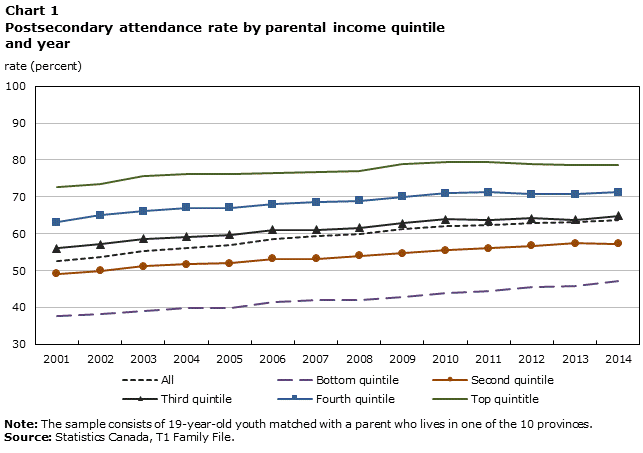
Data table for Chart 1
| Year | All | Bottom quintile | Second quintile | Third quintile | Fourth quintile | Top quintitle |
|---|---|---|---|---|---|---|
| rate (percent) | ||||||
| 2001 | 52.62239 | 37.66566 | 49.13452 | 56.10394 | 63.05967 | 72.63722 |
| 2002 | 53.74874 | 38.13030 | 49.89748 | 57.19543 | 64.96728 | 73.57281 |
| 2003 | 55.19572 | 39.08150 | 51.16623 | 58.56393 | 66.03337 | 75.54261 |
| 2004 | 56.16428 | 39.78105 | 51.71974 | 59.12188 | 66.96564 | 76.09540 |
| 2005 | 56.89732 | 39.95511 | 51.94590 | 59.70283 | 67.08871 | 76.22376 |
| 2006 | 58.46603 | 41.44812 | 53.16116 | 61.02043 | 68.01556 | 76.58681 |
| 2007 | 59.23740 | 42.02820 | 53.24221 | 61.03652 | 68.50942 | 76.82474 |
| 2008 | 59.92562 | 42.12589 | 54.06462 | 61.67455 | 68.91783 | 76.91788 |
| 2009 | 61.20814 | 42.85064 | 54.68778 | 62.84678 | 70.00217 | 78.98919 |
| 2010 | 62.10978 | 43.93066 | 55.52710 | 63.91130 | 70.93113 | 79.42777 |
| 2011 | 62.38404 | 44.36692 | 56.07012 | 63.68044 | 71.25797 | 79.40762 |
| 2012 | 62.85711 | 45.43008 | 56.66460 | 64.23139 | 70.68532 | 78.79899 |
| 2013 | 63.12502 | 45.85927 | 57.39716 | 63.75054 | 70.65223 | 78.62015 |
| 2014 | 63.80526 | 47.05363 | 57.23712 | 64.85563 | 71.18516 | 78.69431 |
|
Note: The sample consists of 19-year-old youth matched with a parent who lives in one of the 10 provinces. Source: Statistics Canada, T1 Family File. |
||||||
Chart 1 also shows that postsecondary enrolment rates also rose among youth from families across the income distribution. However, the gains were not evenly distributed, both in an absolute sense and in a relative sense. In general, larger increases were registered among youth from families with lower income. In 2001, 72.6% of 19-year-olds from families in the top after-tax income quintile were enrolled in postsecondary programs. This figure rose moderately over the next 13 years, reaching 78.7% in 2014. This yielded a 6.1-percentage-point (or 8.3%) increase. In contrast, the enrolment rate among their counterparts in the bottom income quintile increased from 37.7% in 2001 to 47.1% in 2014, a 9.4-percentage-point (or 24.9%) increase.Note 8
The larger relative gains registered by members of the bottom income quintile are shown more clearly in Chart 2. The indicator was developed by dividing the postsecondary enrolment rate among 19-year-olds in the bottom quintile (Q1) of the distribution by the rate among members in the top quintile (Q5). This ratio (Q1/Q5), which is set to 100 at the beginning of the period (2001), rose by 15.3% over the 13-year span.
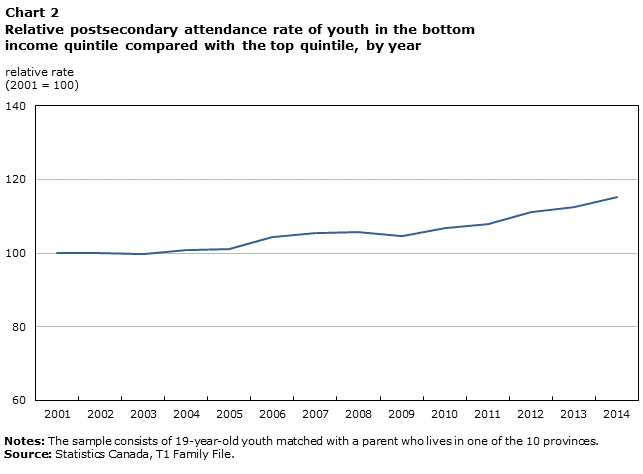
Data table for Chart 2
| Year | Bottom quintile compared with top quintile |
|---|---|
| relative rate (2001 = 100) | |
| 2001 | 100.00 |
| 2002 | 99.94625166 |
| 2003 | 99.76836867 |
| 2004 | 100.81646611 |
| 2005 | 101.08706684 |
| 2006 | 104.36730966 |
| 2007 | 105.50020990 |
| 2008 | 105.61738637 |
| 2009 | 104.61724641 |
| 2010 | 106.66182027 |
| 2011 | 107.74837610 |
| 2012 | 111.18251228 |
| 2013 | 112.48818298 |
| 2014 | 115.30906056 |
|
Notes: The sample consists of 19-year-old youth matched with a parent who lives in one of the 10 provinces. Source: Statistics Canada, T1 Family File. |
|
Strong enrolment growth in East, moderate growth in West
Postsecondary enrolment rates among 19-year-olds from Ontario and provinces east of Ontario increased steadily between 2001 and 2014 (Chart 3). Note 9 Growth was strongest among youth from Newfoundland and Labrador (18.7 percentage points), followed by youth from Ontario (16.1 percentage points), Note 10 Prince Edward Island, New Brunswick, and Quebec (12.8, 12.8 and 11.5 percentage points, respectively). Note 11 Youth from Nova Scotia registered the weakest growth among Eastern provinces (9.1 percentage points), but still outpaced their counterparts from all Western provinces (shown in Chart 4). Among 19-year-olds from Saskatchewan, the postsecondary enrolment rate remained stable during the period, while moderate growth was registered for youth from Manitoba, Alberta and British Columbia (1.6, Note 12 3.6 and 5.9 percentage points, respectively). Overall, enrolment rates remained generally lower in the Western provinces, with the gap widening toward the end of the period, following the oil boom of the 2000s.
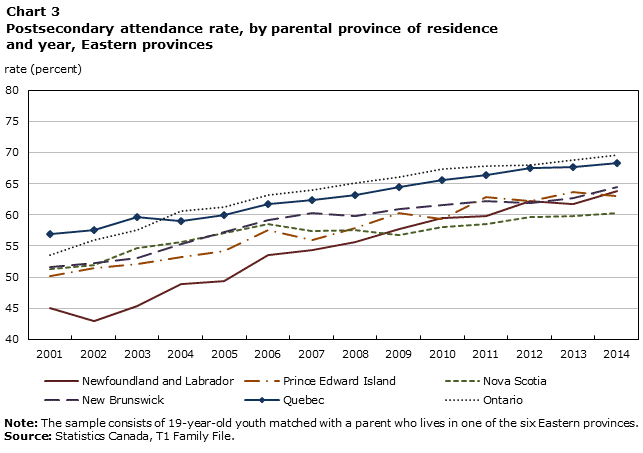
Data table for Chart 3
| Year | Newfoundland and Labrador | Prince Edward Island | Nova Scotia | New Brunswick | Quebec | Ontario |
|---|---|---|---|---|---|---|
| rate (percent) | ||||||
| 2001 | 45.10124 | 50.19634 | 51.28295 | 51.55783 | 56.87878 | 53.51630 |
| 2002 | 42.92969 | 51.45570 | 51.90398 | 52.33352 | 57.63164 | 55.89136 |
| 2003 | 45.37147 | 52.18228 | 54.73611 | 52.99108 | 59.65839 | 57.51274 |
| 2004 | 48.81577 | 53.22785 | 55.61528 | 55.32421 | 59.03735 | 60.61470 |
| 2005 | 49.35656 | 54.25889 | 57.06806 | 57.20094 | 59.93416 | 61.28298 |
| 2006 | 53.57361 | 57.57576 | 58.49335 | 59.24140 | 61.68904 | 63.12385 |
| 2007 | 54.34597 | 55.92417 | 57.33085 | 60.21557 | 62.41857 | 64.02499 |
| 2008 | 55.64631 | 57.88752 | 57.56216 | 59.76639 | 63.25801 | 65.08305 |
| 2009 | 57.69619 | 60.23700 | 56.83807 | 60.89430 | 64.49725 | 66.09276 |
| 2010 | 59.41558 | 59.39436 | 58.06695 | 61.58426 | 65.57658 | 67.34062 |
| 2011 | 59.78624 | 62.85910 | 58.50236 | 62.27865 | 66.41845 | 67.76375 |
| 2012 | 62.22168 | 62.21402 | 59.68951 | 61.87980 | 67.51654 | 68.01767 |
| 2013 | 61.75148 | 63.60182 | 59.78682 | 62.70039 | 67.62285 | 68.72351 |
| 2014 | 63.84498 | 63.03704 | 60.33898 | 64.39714 | 68.36600 | 69.61440 |
|
Note: The sample consists of 19-year-old youth matched with a parent who lives in one of the six Eastern provinces. Source: Statistics Canada, T1 Family File. |
||||||

Data table for Chart 4
| Year | Manitoba | Saskatchewan | Alberta | British Columbia |
|---|---|---|---|---|
| rate (percent) | ||||
| 2001 | 46.40957 | 48.81141 | 47.13992 | 51.71041 |
| 2002 | 46.16689 | 49.40582 | 47.00846 | 52.49363 |
| 2003 | 46.48871 | 48.32221 | 48.86903 | 52.49098 |
| 2004 | 46.67087 | 48.74090 | 47.88236 | 51.23991 |
| 2005 | 47.48567 | 49.23430 | 47.59606 | 52.13869 |
| 2006 | 48.31996 | 49.92444 | 47.92749 | 53.38892 |
| 2007 | 48.33738 | 50.41357 | 49.15966 | 54.06368 |
| 2008 | 47.86915 | 48.81229 | 50.14519 | 53.91942 |
| 2009 | 47.18198 | 48.47887 | 52.22715 | 56.04464 |
| 2010 | 47.77933 | 49.33661 | 52.95361 | 55.61053 |
| 2011 | 47.67777 | 49.28245 | 51.70618 | 55.46619 |
| 2012 | 48.48404 | 48.77260 | 51.65934 | 56.16338 |
| 2013 | 48.63074 | 47.15592 | 51.15375 | 56.63102 |
| 2014 | 48.05195 | 48.69842 | 50.76567 | 57.62082 |
|
Note: The sample consists of 19-year-old youth matched with a parent who lives in one of the four Western provinces. Source: Statistics Canada, T1 Family File. |
||||
Postsecondary enrolment rates in the bottom income quintile substantially outpaced rates in the top income quintile among 19-year-olds from four provinces between 2001 and 2014. Specifically, the Q1/Q5 ratio rose by 29.0% for youth from Ontario, by 20.5% for youth from New Brunswick and Newfoundland and Labrador, and by 9.4% for youth from British Columbia (Chart 5 and 6). In contrast, the Q1/Q5 ratio declined by 30.2% for youth from Saskatchewan over the same period (Chart 6). This decline was largely the result of the enrolment rate falling from 33.8% in 2001 to 22.0% in 2014 among 19-year-olds in the bottom income quintile (an 11.8-percentage-point decline). The enrolment rate declined by 5.0 percentage points in the top income quintile. Note 13Note 14

Data table for Chart 5
| Year | Newfoundland and Labrador | Prince Edward Island | Nova Scotia | New Brunswick | Quebec | Ontario |
|---|---|---|---|---|---|---|
| relative rate (2001 = 100) | ||||||
| 2001 | 100.00 | 100.00 | 100.00 | 100.00 | 100.00 | 100.00 |
| 2002 | 86.1492099 | 88.7890006 | 93.0060451 | 98.3757040 | 101.2256510 | 102.1141265 |
| 2003 | 99.6138232 | 85.3653877 | 100.7940367 | 98.0931346 | 102.2667293 | 102.8760295 |
| 2004 | 104.4980723 | 89.5776241 | 100.0204202 | 106.4061070 | 101.8081412 | 104.7175583 |
| 2005 | 98.3549093 | 93.9510708 | 100.2837970 | 114.5725044 | 100.1492178 | 105.3815611 |
| 2006 | 107.8587461 | 110.2000404 | 95.0177889 | 108.4395353 | 102.4125802 | 109.0186574 |
| 2007 | 105.1820083 | 87.1333895 | 99.3969688 | 104.5204498 | 99.1808504 | 112.1889896 |
| 2008 | 101.0435892 | 85.4520803 | 102.1902852 | 106.4406039 | 96.9521455 | 113.6497947 |
| 2009 | 106.9403217 | 100.9672547 | 94.6184390 | 106.9584889 | 96.9590129 | 112.9902250 |
| 2010 | 112.1236820 | 98.5464997 | 101.0322416 | 109.4607518 | 98.1261414 | 116.7946027 |
| 2011 | 111.2893046 | 101.7479873 | 91.6647845 | 114.0593457 | 99.1957603 | 117.9174266 |
| 2012 | 116.4940879 | 100.1220410 | 96.5542758 | 114.3188632 | 100.5403496 | 123.4679634 |
| 2013 | 126.5045191 | 113.7531179 | 97.0099185 | 106.0021026 | 99.6945536 | 124.6058966 |
| 2014 | 120.4668668 | 91.9944591 | 102.6777896 | 120.4835823 | 101.4158181 | 128.9921915 |
|
Note: The sample consists of 19-year-old youth matched with a parent who lives in one of the four Western provinces. Source: Statistics Canada, T1 Family File. |
||||||
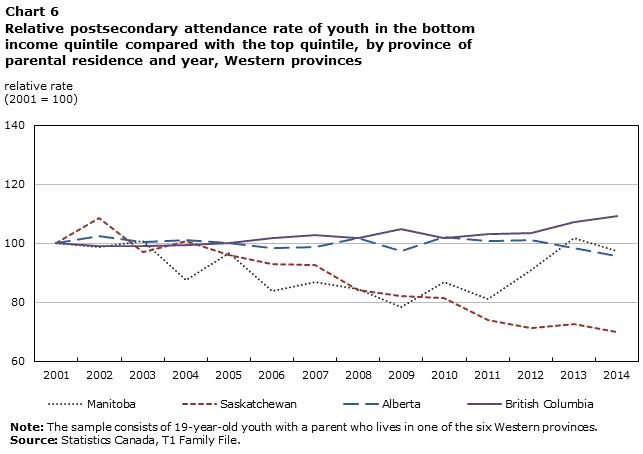
Data table for Chart 6
| Year | Manitoba | Saskatchewan | Alberta | British Columbia |
|---|---|---|---|---|
| relative rate (2001 = 100) | ||||
| 2001 | 100.00 | 100.00 | 100.00 | 100.00 |
| 2002 | 98.82453896 | 108.70000649 | 102.41761975 | 99.12875318 |
| 2003 | 100.62744307 | 96.87964353 | 100.48435508 | 98.91980308 |
| 2004 | 87.43552503 | 100.80479337 | 101.13565455 | 99.32060659 |
| 2005 | 96.78434859 | 96.03915712 | 100.03644015 | 100.02600288 |
| 2006 | 83.90070247 | 93.02191079 | 98.49404459 | 101.70072058 |
| 2007 | 86.71331550 | 92.72519199 | 98.71419368 | 102.78638652 |
| 2008 | 84.55785657 | 84.21456981 | 101.92704923 | 101.83527191 |
| 2009 | 78.27141738 | 82.01167609 | 97.42152275 | 104.74938645 |
| 2010 | 86.89986670 | 81.31066312 | 102.20416452 | 101.81331103 |
| 2011 | 81.04340933 | 73.88129483 | 100.67447852 | 103.29579630 |
| 2012 | 90.75832239 | 71.17796121 | 101.05936263 | 103.31599724 |
| 2013 | 101.85147313 | 72.57265709 | 98.22682453 | 107.33904239 |
| 2014 | 97.42413408 | 69.82732546 | 95.71973287 | 109.39264637 |
|
Note: The sample consists of 19-year-old youth matched with a parent who lives in one of the four Western provinces. Source: Statistics Canada, T1 Family File. |
||||
Young women still outnumbering young men in postsecondary institutions
It has been well documented that educational attainment has increased faster among women than among men. This is largely the result of gains made by young women in the 1980s and 1990s (Frenette and Coulombe 2007).
Throughout the study period (2001 to 2014), young women were considerably more likely to attend postsecondary institutions than young men. In 2001, 61.1% of 19-year-old women attended postsecondary institutions, compared with 45.2% of 19-year-old men (Chart 7). The absolute and relative gender differences did not change much over the following 13 years, as enrolment rates reached 56.5% for young men and 71.7% for young women in 2014. The enrolment trends by parental province of residence and parental income were also similar for young men and young women, mirroring those shown in Charts 1 through 6. Note 15
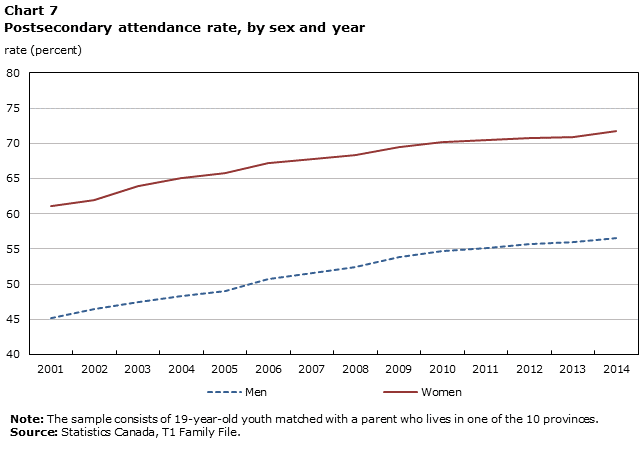
Data table for Chart 7
| Year | Men | Women |
|---|---|---|
| rate (percent) | ||
| 2001 | 45.15217 | 61.09419 |
| 2002 | 46.46093 | 61.93784 |
| 2003 | 47.44119 | 63.96844 |
| 2004 | 48.24253 | 65.09205 |
| 2005 | 48.98754 | 65.70957 |
| 2006 | 50.66459 | 67.15198 |
| 2007 | 51.55416 | 67.81084 |
| 2008 | 52.40313 | 68.25798 |
| 2009 | 53.79728 | 69.40212 |
| 2010 | 54.68635 | 70.24144 |
| 2011 | 55.06036 | 70.40905 |
| 2012 | 55.71666 | 70.70546 |
| 2013 | 56.02791 | 70.91475 |
| 2014 | 56.53636 | 71.72495 |
|
Note: The sample consists of 19-year-old youth matched with a parent who lives in one of the 10 provinces. Source: Statistics Canada, T1 Family File. |
||
Conclusion
The objective of this study was to document trends in postsecondary enrolment rates among 19-year-olds matched to their parents in the personal income tax files. Results by quintile of parental income, province of parental residence and sex were produced.
The study found that the percentage of 19-year-olds enrolled in a postsecondary education program increased steadily from 2001 to 2014 among youth from families across the income distribution, but particularly at the bottom of the income distribution. Postsecondary enrolment rates increased fastest among youth from Newfoundland and Labrador, and Ontario, as well as from other Eastern provinces. Among 19-year-olds from Ontario, New Brunswick, and Newfoundland and Labrador, the largest gains occurred at the bottom of the income distribution.
Gains in enrolment rates were more moderate among 19-year-olds from Western provinces. Among those from Saskatchewan, no increases were registered, and this was largely because of a considerable decline in postsecondary enrolment among youth from the bottom of the income distribution.
Young women were more likely to be enrolled than young men throughout the period, with the gap remaining more or less constant over the 13-year span. The enrolment trends by parental province of residence and parental income were also similar for young men and young women.
Appendix: Data validation
The use of personal income tax data to measure postsecondary enrolment introduces at least four statistical issues. The first is that postsecondary students do not necessarily need to claim the tuition, education and textbook credits for themselves, nor do they need to make the claim during the year in which they were enrolled. This raises questions about the ability of tax data to accurately reflect trends in postsecondary enrolment. Second, about one-quarter of 19-year-old youth could not be matched to a parent. Consequently, no reliable measure of available economic resources could be assigned to these unmatched youth, since many may still depend on their parents for financial assistance. Indeed, student financial aid systems generally take the income of parents into consideration in determining available resources. Third, parental income and province of residence are measured when youth are 19 years old (to maximize the match rate between youth and parents). However, these may not correspond to the jurisdiction and the financial means of parents at the time when their child made the decision to attend a postsecondary institution or not. Fourth, only one year of parental income is used. Although this corresponds to the approach used in student financial aid systems to determine expected parental contributions, parents may draw on other financial resources to help pay for their children’s education. These four issues are addressed below in sequence.
The first issue is that postsecondary students need not claim the tax credits for themselves, nor do they need to make the claim during the year in which they were enrolled. Indeed, if students do not work (or do not work much), then the credits may not benefit them. Some may choose to transfer the credits to their parents during the year when they attended a postsecondary institution, or they may carry forward the credits until they have more taxes to pay. However, as described in the “Data and definitions” section, individuals who attend postsecondary institutions still have to complete a Schedule 11 form (Tuition, Education, and Textbook Amounts) if they wish to transfer the amounts to a designated individual or to determine the unused amounts available to be carried forward. Nevertheless, there is no strict obligation to claim the credits at all, and some students may completely avoid doing so either through lack of awareness or for some other reason.
To assess the extent to which this occurs, a version of the Postsecondary Student Information System (PSIS) linked to the T1 Family File (T1FF) database is used. The PSIS–T1FF file is an ongoing project that aims to link enrolment and graduation information from the PSIS, which is collected from postsecondary institutions by Statistics Canada, to tax data. At present, data from Atlantic Canada from 2005 to 2013 are available, with near-complete coverage in all years. Among 19-year-olds who attended a postsecondary institution in Atlantic Canada between 2005 and 2013, between 74.3% and 78.2% had filed their income taxes and claimed tuition, education and textbook credits in the personal income tax files (depending on the year). Some students may not have been eligible to claim these credits, such as those who took pre-postsecondary qualifying courses, non-program courses, or basic education and skills programs (not geared towards a particular occupation), or those who were registered neither full time nor part time (e.g., co-op students and apprentices). When these students were removed from the sample, between 79.1% and 81.8% claimed the credits.
While tax data do not identify about 20% of postsecondary students who are eligible to claim the credits, they are expected to capture some postsecondary students who are not in the PSIS. Data in the PSIS are collected on a specific day between September 30 and December 1. This “snapshot” date varies from institution to institution. Students who were not enrolled on the snapshot date but who were enrolled at another point during the tax (calendar) year could potentially be eligible for the tax credits. The tax credits are also available for private-school enrollees (the PSIS is limited to public institutions), Note 16 as well as for individuals who pay examination fees for professional certification.
Given all of the caveats noted above, neither data source is expected to capture all postsecondary enrolment. The important question is whether both generate similar trends in postsecondary enrolment rates. By dividing enrolment counts by population estimates (from CANSIM table 051-0001 [Statistics Canada n.d.d]), an enrolment rate can be generated. Note 17 For comparability between the T1FF and the PSIS, all 19-year-old youth Note 18 from Canada are included, not just youth who are matched to a parent (a concept relevant only in the T1FF).
In 2001, 45.7% of 19-year-old youth were enrolled in postsecondary programs according to the T1FF, compared with 38.1% in the PSIS (Chart A.1). Both data sources suggest considerable growth in the enrolment rate over the next 13 years, reaching 57.8% in the T1FF and 50.8% in the PSIS. This is a 12.1-percentage-point increase in the T1FF, compared with a 12.7-percentage-point increase in the PSIS. Thus, while the enrolment rates are somewhat higher in the T1FF (as expected given the annual nature of postsecondary enrolment in the tax data), the trend is similar to what administrative data from postsecondary institutions would suggest. Note 19
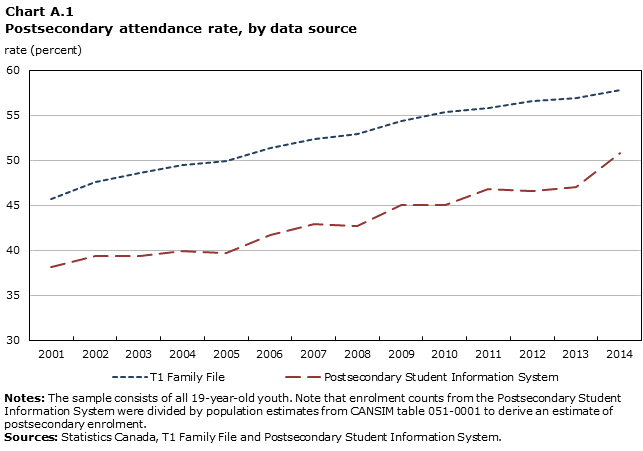
Data table for Chart A.1
| Year | T1 Family File | Postsecondary Student Information System |
|---|---|---|
| rate (percent) | ||
| 2001 | 45.69249 | 38.10515882 |
| 2002 | 47.62372 | 39.36048813 |
| 2003 | 48.58782 | 39.35930487 |
| 2004 | 49.51737 | 39.91393988 |
| 2005 | 49.92871 | 39.74102435 |
| 2006 | 51.37558 | 41.71269580 |
| 2007 | 52.33583 | 42.89440001 |
| 2008 | 52.93345 | 42.67155604 |
| 2009 | 54.37088 | 45.02890124 |
| 2010 | 55.40002 | 45.08847065 |
| 2011 | 55.87586 | 46.85514971 |
| 2012 | 56.63967 | 46.62566100 |
| 2013 | 56.97850 | 47.02178258 |
| 2014 | 57.78210 | 50.82580845 |
|
Notes: The sample consists of all 19-year-old youth. Note that enrolment counts from the Postsecondary Student Information System were divided by population estimates from CANSIM table 051-0001 to derive an estimate of postsecondary enrolment. Sources: Statistics Canada, T1 Family File and Postsecondary Student Information System. |
||
The second issue raised by the use of tax data to measure postsecondary enrolment relates to the fact that about one-quarter of 19-year-old youth could not be matched to a parent; thus, no reliable measure of available economic resources could be assigned to a non-negligible share of youth. Note 20 Chart A.2 displays the postsecondary enrolment rates for these unmatched youth across the 10 provinces over the study period. The rates ranged from 28.9% in 2001 to 42.8% in 2014. Although it is not possible to know the level of parental income for these youth, it is evident that their enrolment rates are consistently lower than those of youth in the bottom income quintile. However, the trend for unmatched youth is qualitatively similar to that for other youth.
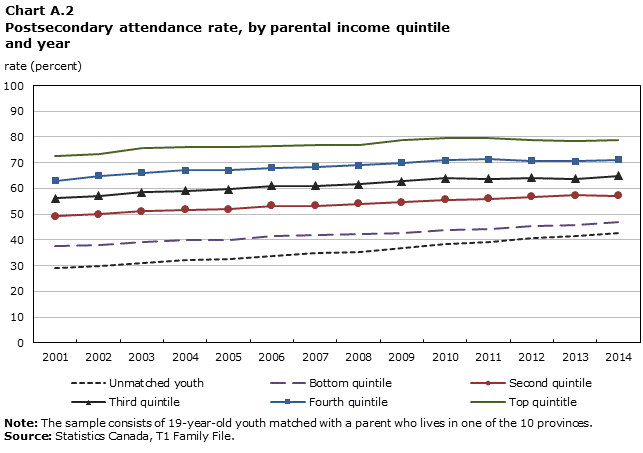
Data table for Chart A.2
| Year | Unmatched youth | Bottom quintile | Second quintile | Third quintile | Fourth quintile | Top quintitle |
|---|---|---|---|---|---|---|
| rate (percent) | ||||||
| 2001 | 28.89095 | 37.66566 | 49.13452 | 56.10394 | 63.05967 | 72.63722 |
| 2002 | 29.95233 | 38.13030 | 49.89748 | 57.19543 | 64.96728 | 73.57281 |
| 2003 | 31.03727 | 39.08150 | 51.16623 | 58.56393 | 66.03337 | 75.54261 |
| 2004 | 32.32079 | 39.78105 | 51.71974 | 59.12188 | 66.96564 | 76.09540 |
| 2005 | 32.69638 | 39.95511 | 51.94590 | 59.70283 | 67.08871 | 76.22376 |
| 2006 | 33.90395 | 41.44812 | 53.16116 | 61.02043 | 68.01556 | 76.58681 |
| 2007 | 34.86254 | 42.02820 | 53.24221 | 61.03652 | 68.50942 | 76.82474 |
| 2008 | 35.45696 | 42.12589 | 54.06462 | 61.67455 | 68.91783 | 76.91788 |
| 2009 | 36.85291 | 42.85064 | 54.68778 | 62.84678 | 70.00217 | 78.98919 |
| 2010 | 38.20293 | 43.93066 | 55.52710 | 63.91130 | 70.93113 | 79.42777 |
| 2011 | 39.20776 | 44.36692 | 56.07012 | 63.68044 | 71.25797 | 79.40762 |
| 2012 | 40.76193 | 45.43008 | 56.66460 | 64.23139 | 70.68532 | 78.79899 |
| 2013 | 41.39325 | 45.85927 | 57.39716 | 63.75054 | 70.65223 | 78.62015 |
| 2014 | 42.78260 | 47.05363 | 57.23712 | 64.85563 | 71.18516 | 78.69431 |
|
Note: The sample consists of 19-year-old youth matched with a parent who lives in one of the 10 provinces. Source: Statistics Canada, T1 Family File. |
||||||
The third issue relates to the fact that parental income and province of residence are measured when youth are 19 years old. Ideally, some measure of parental financial resources and province of residence while youth are still in high school would be available, since this is likely when most youth decide to pursue a postsecondary education. However, parental match rates decline as youth are targeted at an earlier age. This is because the tax-filing rates of youth increase considerably throughout the teenage years. Although children can be identified as being present at age 17, for example, they cannot always be followed to a later period (such as age 19) in a reliable manner when a longitudinal version of tax data is used, especially if they were not tax filers at age 17 (i.e., they were imputed). An alternative strategy would be to follow parents who are matched to 19-year-old youth backwards in time. This would also involve additional sample loss because of family re-composition and non-filing among parents.
Are parental province of residence and an income measure when youth are aged 19 reasonable proxies for these variables at age 17? The concern is that parents may work longer hours or move closer to support their child as they attended postsecondary education.
To test this hypothesis, the final six-year panel of the Survey of Labour and Income Dynamics (SLID) (Statistics Canada n.d.b) was used; a sample of children aged 14 in 2005 was followed to 2010, when they were 19 years old. Parents were identified when the children were 14 years old and then subsequently followed until the children were 19 (regardless of whether they remained in the same family). This resulted in a panel dataset consisting of 1,669 person-years for the parental provincial mobility analysis and a panel dataset consisting of 2,013 person-years for the parental income analysis. Note 21The dependent variables in the first models consisted of a dummy (binary) variable indicating parental provincial mobility between the previous year and the current year, while in the second model, it consisted of the sum of after-tax income of the parents in the current year. The key independent variable was a dummy variable indicating postsecondary enrolment of the child during the year. The model included the following covariates, all measured when the child was 14: the highest level of parental education of either parent, the average number of years of full-time-equivalent work experience of the parents, and the province of residence of the family. In addition, the model included year dummy variables, as well as child-specific fixed effects. The model results showed that both parental provincial mobility and parental income were statistically invariant to the postsecondary attendance status of the child. In both cases, coefficient estimates were small and not statistically significant at the 70% level, which strongly suggests that parents do not respond to their children’s postsecondary attendance decision by moving provinces or changing their income levels.
The fourth issue is that using only one year of parental income may not accurately reflect the parents’ long-term financial means. However, Drolet (2005) found evidence that the relationship between parental income and university participation among a sample of 18- to 24-year-olds is very similar whether one, two or three years of parental income are used.
Data and definitions
Data sources
This study uses the T1 Family File (T1FF) from 2001 to 2014. The sample includes 19-year-olds matched with a parent who lives in one of the 10 provinces. Individuals from the territories are excluded, since no Consumer Price Index is available for these regions. The total sample of matched 19-year-olds across the 10 provinces ranges from 264,764 to 285,944, depending on the year. Overall, the T1FF accounts for approximately 95% of the population.
Methodology
Youth aged 19 who are matched to a parent in the personal income tax files are examined in this study. This includes tax-filing children who reported the same address as a parent, as well as non-filing children identified (imputed) from provincial birth files and historical tax files. The vast majority of 19-year-olds matched to a parent are tax filers. Overall, between 71.9% and 75.6% of 19-year-olds were matched to a parent, depending on the year. The remainder, who were not listed as children in the tax files, are analyzed separately, since there is no link between parent and child.
The age of 19 was selected because younger individuals may not all be eligible to attend postsecondary institutions (e.g., if they have not graduated from high school yet), while older individuals are less likely to be matched to a parent.
Parental income quintiles (sorted groups of 20% of the sample) are created for all provinces together, as well as for each individual province. In each case, fixed income thresholds from 2014 are used. Income is also expressed in 2014 constant dollars using the Canadian and provincial all-items Consumer Price Index (CANSIM table 326-0021 [Statistics Canada n.d.c]). The quintiles are based on all 19-year-olds in the sample. Similar results were obtained when the results were weighted by the number of individuals in the family.
A key indicator used in the study is the ratio of the postsecondary enrolment rate among individuals in the bottom income quintile to the rate among individuals in the top quintile. To better visualize trends, this ratio is set to 100 at the beginning of the period of analysis (2001).
Unless otherwise stated, all differences noted in the study are statistically significant at the 1% level.
Definitions
Postsecondary enrolment: Individuals are classified as having been enrolled in a postsecondary program if they claimed a positive amount of tuition, education or textbook credits in Schedule 11 of their personal income tax form (T1 General tax form). A positive amount for any of these credits signals attendance. Postsecondary students at qualifying institutions receive a T2202A form (Tuition, Education, and Textbook Amounts Certificate form) for the tuition amount and a T2202 form (Education and Textbook Amounts Certificate form) for the education and textbook amounts. Students may use this information to claim these amounts as non-refundable tax credits (i.e., the amounts can be used to reduce taxes owing but are non-refundable beyond the amount of taxes owing). If students cannot apply all of their credits towards their taxes in a given year, they may opt to transfer some or all of their credits to their spouse or common-law partner, or to a parent or grandparent, or to a parent or grandparent of their spouse or common-law partner. Alternatively, they may carry forward some or all of the credit amounts to a future tax year. In any of these cases, a Schedule 11 form must be filled out, which allows for the identification of students who are enrolled in a postsecondary program during the appropriate tax year. However, no distinction can be made between different forms of postsecondary schooling in the tax data.
Parental income: The total income of parents from all sources, less income taxes, expressed in equivalent dollars. This approach expresses parental income on a per-family-member basis and accounts for economies of scale associated with larger families. This is accomplished by dividing income by the square root of the number of family members.
Parental province of residence: The family’s province of residence, corresponding to the most recent address on file at the Canada Revenue Agency in the year following the tax year (e.g., 2015 for the 2014 tax year) at the time of the creation of the file. This is generally the address at the time when the tax form was completed (by April 30 for paid employees and by June 15 for self-employed individuals). In some instances, the most recent address may correspond to information in other files related to the income tax system (e.g., the Canada Child Tax Benefit, which collects the address in July or August, and investment slips). The T1FF database also includes late filers who provide their address later in the year. In specific situations, individuals who live away from their family might still be included in the family for tax purposes (e.g., university students may be matched with their parents based on information in the parents’ tax forms).
References
Corak, M., G. Lipps, and J. Zhao. 2003. Family Income and Participation in Post-secondary Education. Analytical Studies Branch Research Paper Series, no. 210. Statistics Canada Catalogue no. 11F0019M. Ottawa: Statistics Canada.
Drolet, M. 2005. Participation in Post-secondary Education in Canada: Has the Role of Parental Income and Education Changed over the 1990s? Analytical Studies Branch Research Paper Series, no. 243. Statistics Canada Catalogue no. 11F0019M. Ottawa: Statistics Canada.
Emery, H., A. Ferrer, and D. Green. 2011. Long Term Consequences of Natural Resource Booms for Human Capital Accumulation. Canadian Labour Market and Skills Researcher Network Working Paper no. 74. Vancouver: Canadian Labour Market and Skills Researcher Network.
Frenette, M. 2007. Why Are Youth from Lower-income Families Less Likely to Attend University? Evidence from Academic Abilities, Parental Influences, and Financial Constraints. Analytical Studies Branch Research Paper Series, no. 295. Statistics Canada Catalogue no. 11F0019M. Ottawa: Statistics Canada.
Frenette, M., and S. Coulombe. 2007. Has Higher Education Among Young Women Substantially Reduced the Gender Gap in Employment and Earnings? Analytical Studies Branch Research Paper Series, no. 301. Statistics Canada Catalogue no. 11F0019M. Ottawa: Statistics Canada.
Hango, D. 2011. “Length of time between high school graduation and enrolling in postsecondary education: Who delays and who does not?” Education Matters: Insights on Education, Learning and Training in Canada 8 (4). Statistics Canada Catalogue no. 81-004-X.
Li, C. 2006. Canada’s Private Colleges: The Lesser Known Players in Postsecondary Education. Analysis in Brief, no. 36. Statistics Canada Catalogue no. 11-621-M. Ottawa: Statistics Canada.
Morissette, R., P.C.W. Chan, and Y. Lu. 2014. Wages, Youth Employment, and School Enrollment: Recent Evidence from Increases in World Oil Prices. Analytical Studies Branch Research Paper Series, no. 353. Statistics Canada Catalogue no. 11F0019M. Ottawa: Statistics Canada.
Neill, C. 2007. Canada’s Tuition and Education Tax Credits. Montréal: Canada Millennium Scholarship Foundation.
Shaker, E., D. Macdonald, and N. Wodrich. 2013. Degrees of Uncertainty: Navigating the Changing Terrain of University Finance. Ottawa: Canadian Centre for Policy Alternatives.
Statistics Canada. n.d.a Postsecondary Student Information System. Last updated January 31, 2017. Available at: http://www23.statcan.gc.ca/imdb/p2SV.pl?Function=getSurvey&Id=252579 (accessed February 27, 2017).
Statistics Canada. n.d.b Survey of Labour and Income Dynamics. Last updated June 26, 2013. Available at: http://www23.statcan.gc.ca/imdb/p2SV.pl?Function=getSurvey&SDDS=3889 (accessed February 27, 2017).
Statistics Canada. n.d.c Table 326-0021 Consumer Price Index annual (2002-100) (table). CANSIM (Database). Last updated January 19, 2017. Available at: http://www5.statcan.gc.ca/cansim/a26?lang=eng&retrLang=eng&id=3260021 (accessed February 27, 2017).
Statistics Canada. n.d.d Table 051-0001 Estimates of population, by age group and sex for July 1, Canada, provinces and territories annual (persons unless otherwise noted) (table). CANSIM (Database). Last updated September 27, 2016. Available at: http://www5.statcan.gc.ca/cansim/a26?lang=eng&retrLang=eng&id=0510001 (accessed February 27, 2017).
Statistics Canada. n.d.e Table 477-0021 Weighted average tuition fees for full-time Canadian undergraduate students, by field of study, annual (dollars) (table). CANSIM (Database). Last updated September 6, 2016. Available at: http://www5.statcan.gc.ca/cansim/a26?lang=eng&id=4770021&p2=17 (accessed February 27, 2017).
Notes
- Date modified:

